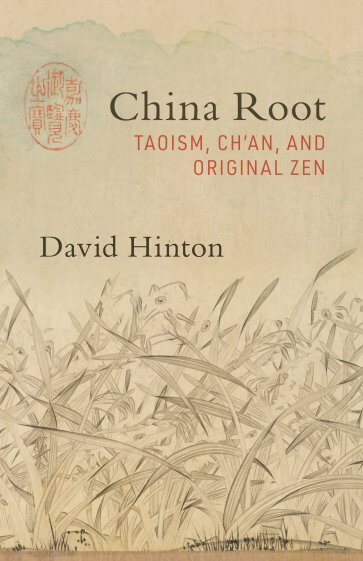In perennial Absence you see mystery, and in perennial Presence you see appearance. Though the two are one and the same, once they arise, they differ in name. One and the same they’re called dark-enigma, dark-enigma deep within dark-enigma, gateway of all mystery. — Dao de jing, Chapter One

Buddhism—in particular Chan—and Daoism in China are inextricably linked and share a mutually influential relationship. However, perceptions about this relationship have often been dominated by the glory of Chan and Daoist high points during the medieval Tang dynasty, or the aesthetic refinement of Japanese Zen that came to be so welcomed in Western thought. While these emphases are rightly celebrated, poet and translator David Hinton has made a conscious effort to take the Chan-Daoism relationship beyond these historical periods, back into the very earliest days of the Daoist tradition in the fourth century BCE and its antecedents in the Palaeolithic era.
The result is China Root: Taoism, Ch’an, and Original Zen, in which the central premise is that Chan was not just vitally influenced by Daoism, but is a refinement and extension of it. (8–10) Hinton’s recasting of Chan as the Buddhist answer to Daoism is deliberate, and we must see the book’s appendix to explore his rationale: Anglophone literature on Zen is missing Chan’s conceptual framework (through misunderstanding or faulty translations, early translators misrepresented Chan’s native cosmology):
. . . when Buddhism arrived in China during the first century of the current era, it was fundamentally reinterpreted and reshaped by Taoist thought, its more abstract metaphysical sensibility becoming grounded in an earthly and empirically based vision. The result of this amalgam, which began to take shape from the third into the fifth centuries c.e., is Ch’an. And in this transformation, Buddhism is so transformed by Taoist thought that, aside from a few institutional trappings, it is scarcely recognizable as Buddhism at all. But it may be still more accurate to simply say that the influence of Buddhism pushed native Chinese philosophy to a new level of clarity and intensity, for the originators of Ch’an essentially adopted aspects of Buddhism (texts, ideas, practices) that they found useful in enriching their own Taoist understanding, while reconceiving them fundamentally in Taoist terms. Most important among these imported Buddhist elements was a central focus on the nature of empty-mind, consciousness emptied of all content, a focus cultivated through a highly developed practice of empty-mind meditation known as dhyana. . . . But it appears that in its migration to Japan and, over a millennium later, from Japan to America, Ch’an’s native philosophical framework was largely forgotten, for it is all but absent in modern American teaching texts and translations of the original Ch’an literature. (6–7)
When this conceptual framework is brought back into the discussion, Chan’s relationship with Daoism suddenly appears much more prominent.
Hinton’s premise is simple, but with very significant implications:
In the official Ch’an legend, Bodhidharma brought Ch’an from India more or less fully formed around 500 c.e., but his teaching is clearly built from the traditional Taoist conceptual framework, a fact revealed most simply in the way he depends on terms and concepts central to that Taoist system. In fact, Ch’an’s origins are found a century or two earlier when Buddhist artist-intellectuals began melding Buddhism and Dark-Enigma Learning, which was broadly influential among artist-intellectuals at the time. (28)
Hinton suggests that Chan arose from the interaction between Daoism and Buddhist thought from Seng Chao and Tao Sheng, but in particular, Hsieh Ling-yün (385–433). (32) The genealogy of Chan’s interaction with Daoism began very early on, from as early as the First Patriarch, Bodhidharma:
In the dhyana Buddhism that migrated to China from India, samadhi simply meant ‘consciousness emptied of all subjective content.’ But it was transliterated into Chinese as 三昧地, which means ‘three-shadowed earth.’ That begins to suggest samadhi’s meaning in Ch’an: empty-mind free of all conceptual structures, self dismantled completely by the Ch’an wrecking-crew, leaving consciousness open to its ‘original-nature’ as the Cosmos moving in perfect tranquility at that all-encompassing and perennial origin-place that Lao Tzu called Absence. (135–6)

As an award-winning poet and experienced translator of Chinese texts, Hinton is well-placed to engage with Daoism through fresh terms beyond ossified translations of a tradition for which the original conceptual framework is missing or incomplete in contemporary teaching. Some of these translated terms are particularly expressive and poetic. Wu (無) is translated as “absence,” I am partial to dark-enigma, which is Hinton’s translation of xuan (玄): the Daoist ultimate reality, so to speak, which Chan’s project of conceptual deconstruction and return to natural being also reaches: dark-enigma is a “single concept, a single linguistic darkness, and this darkness is itself the cosmological/ontological ground: that undifferentiated and generative tissue of the Cosmos seen as a single organic whole.” (91)
In other words, Hinton argues that Chan Buddhism and Daoism share the same spiritual goal. He explains:
Dark-enigma cannot be portrayed directly because it is exactly the generative existence-tissue prior to the distinctions of forms, of names, or even of consciousness separate from things. But in its blur of all the foundational ideas, dark-enigma points the way past language and the knowable to wordless awakening. (94)
Both Chan and Daoism, Hinton argues, guide the practitioner to dark-enigma, “that dark vastness beyond word and thought, origin of all creation and all destruction.” (55) In this sense, Chan is itself a rebellion against Buddhism, for “the originators of Ch’an essentially adopted aspects of Buddhism (texts, ideas, practices) that they found useful in enriching their own Taoist understanding, while reconceiving them fundamentally in Taoist terms.” (7) Hinton outright says that Buddhism is only a scrim on the surface of Chan. (7) He then lays out his argument in chapters covering the key shared rubrics of Ch’an and Daoism: “tao,” “meditation,” “breath,” “mind,” and “words,” in Part One; “absence,” “empty-mind,” “mirror,” “rivers-and-mountains,” “Dharma,” “Buddha,” and “dark-enigma” in Part Two; and finally “absence-action,” “meditation,” “sangha-case,” “unborn,” and “awakening” in Part Three. All sections attempt to bridge Daoist and Chan elements, highlighting the continuity of philosophy between the two traditions:
At depth, Ch’an’s deconstructive project extends a tradition of demolition that was the essence of Taoism from its origins in the Tao Te Ching, and the end result of the dismantling is defined by the earthy Taoist/Ch’an conceptual framework. (7)
This book is unique not only because of its eloquence and fresh presentation of Chan as a Buddhist refinement of Daoism, but also because this work has the potential to be an interfaith work of comparative theology, in which the texts of two religious traditions are jointly read in a spirit of seeking mutual understanding whie remaining rooted in a particular tradition. Yet there is much more interfaith work to be done in a contemporary context, which Hinton briefly addresses. The model of Chan and Daoist interaction is empirically based, profoundly gynocentric in its cosmology as opposed to the patriarchal cosmology that carries on from the Shang Dynasty onward, and is all about “deep-ecology,” (11) uniting human consciousness with the natural world. Contemporary, comparative theology and Daoist-Buddhist dialogues should proceed from these rubrics, which would help spiritual seekers touch the “earthy mystery” (14) in daily life.
This book reminds us that Chan is not simply the shed skin or exoskeleton of the Zen organism, which hopped from India to China and then to Japan before flying to the West. The conceptual framework of Chan inevitably lies in its relationship with Daoism, which opened to China’s artist-intellectuals, and then everyone else, the possibility of weaving consciousness into the landscape, the planet, and the universe itself.















I find all this very confusing and I’d rather stick to the Sixth Patriarch Hui Neng’s words: “Tao is to be understood by the awakening mind and has nothing to do with sitting (in meditation)…..because it is beyond birth and death, it is the Tathagata’s pure and clean Ch’an. When all things (are perceived as) void and still, this is the Tathagata’s pure and clean sitting. There is even no realisation in the end, still less is there sitting (in meditation).